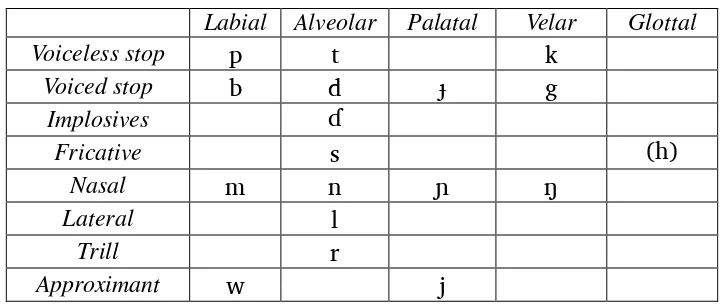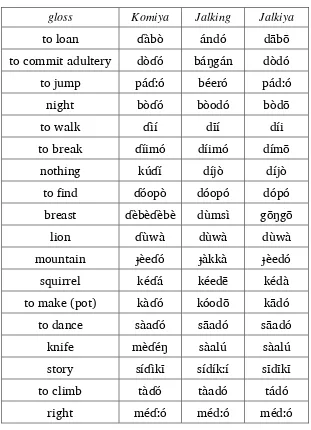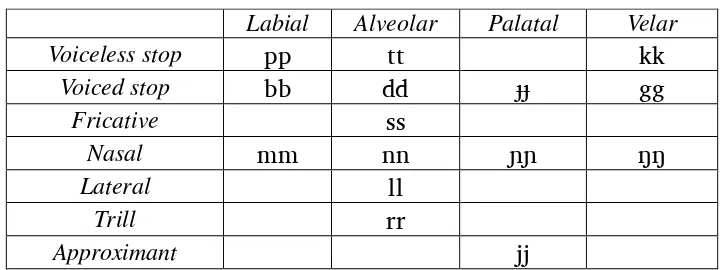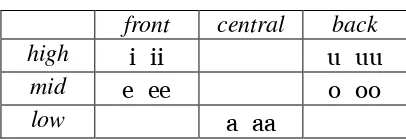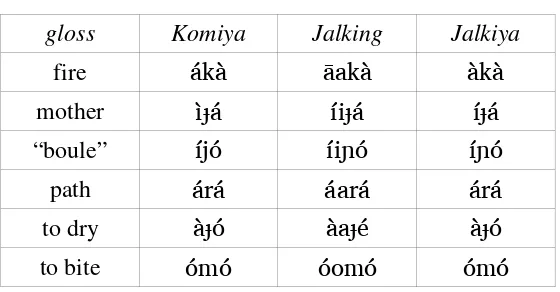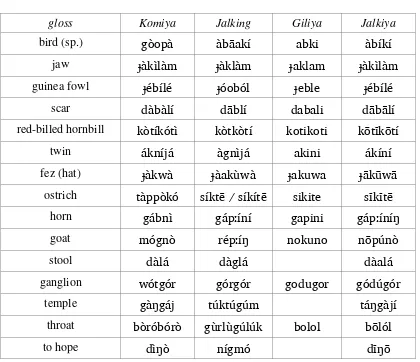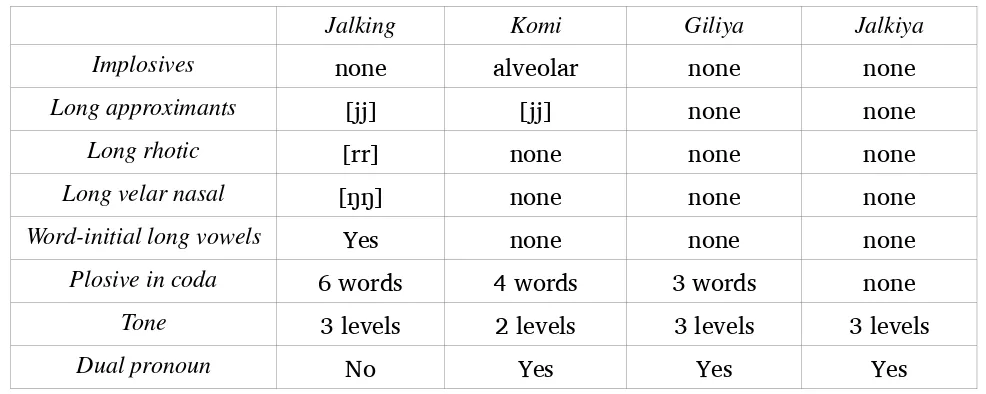Digital
Resources
®
Electronic Working Paper 2011-011
The Dialects of Baraïn
(East Chadic)
The Dialects of Baraïn (East Chadic)
Joseph Lovestrand
SIL International
®2011
SIL Electronic Working Papers 2011- 011
Contents
Abstract
1 Introduction 2 Background
3 Phonological segments and tone 3.1 Consonants
3.2 Vowels 3.3 Tone
4 Syllable structures 5 Lexical similarities
5.1 Jalkiya and Giliya 5.2 Jalkiya and Jalking 5.3 Jalkiya and Komiya 5.4 Jalking and Komiya 6 Summary
7 Conclusion
Abstract
The Baraïn language is spoken in the Guera region of Chad (East Chadic, B3; or “Barein” [bva]). This community of approximately 6,000 speakers divide themselves into four distinct subgroups: Jalkiya, Giliya, Jalking, and Komiya. While two of the four are geographically and linguistically very close to one another (Jalkiya and Giliya), the other two speak dialects of the language that differ lexically and phonologically to such a degree that intercomprehension is not normally possible. In this situation, the speakers of these subgroups communicate with each another exclusively in Chadian Arabic—the language of wider communication. Wordlists gathered from each subgroup serve as the basis of this preliminary examination of the differences in each speech variety. The description covers phonological segments, tone, syllable structures, distribution of consonants, and lexical differences. One outstanding phonological feature is that none of the dialects have a bilabial implosive and only one has an alveolar implosive. Both of these segments were previously assumed to be universal in Chadic languages. This research was done in the context of a mother-tongue literacy program and draws the conclusion that two of the Baraïn varieties may be able to share literacy materials (Jalkiya and Giliya). However, the other two subgroups will undoubtedly need to develop separate materials.
1 Introduction
This paper compares the four dialects1 of the Baraïn language spoken in the Republic of Chad (East
Chadic, B3). It represents the first phonological analysis of the varieties of speech within the
language and includes data from one dialect that has never before been documented. Among Chadic
languages, Baraïn is unique in that it is the only one that has no bilabial implosives. In addition,
alveolar implosives exist in only one of the four dialects. Finally, the data demonstrates that there are
significant phonological and lexical differences in some dialects, so much so that, where these
differences occur, speakers of one dialect must communicate with speakers of other dialects in
Chadian Arabic.
This paper is organized as follows: Section 2 gives a general description of the Baraïn language setting.
Section 3 presents the phonological segments of each dialect highlighting the differences between
them. Section 4 discusses the differences in syllable structure and the distribution of consonants.
Section 5 presents the results of a comparative wordlist, demonstrating relatively low lexical
1
similarities. Section 6 presents a summary of each major difference among the various dialects, and
Section 7 discusses the implications of this analysis to an on-going literacy program. Lastly, an
appendix presents the entire comparative wordlist used in this analysis.2
2 Background
Baraïn (or Barein, [bva]) is spoken by an estimated 6,000 people living in 30 to 40 villages in the
Guera region (préfecture) in central Chad. In the 15th edition of Ethnologue: Languages of the World
(Gordon 2009) the name “Barein” is used for this ethnic group. This designation likely comes from
research published by Johannes Lukas in German (Lukas 1937). The French spelling is used here in the
hope that it better reflects the local pronunciation: [ ].
The language is classified in the Afro-Asiatic family as an East-Chadic language (Gordon 2009,
Newman 1977). An early classification of Baraïn is found in Greenberg's work on African languages.
Under his system the language finds itself in group 9.c. (1966:46). A later reworking of Chadic
classifications by Newman divided East-Chadic languages into two groups labeled A and B (Newman
1977). Group B is further divided into three subgroups: group 1 representing the northern languages,
group 2 for Gergiko (Mukulu, [moz]), and group 3 for the southern languages. The southern group
includes Baraïn, Sokoro [sok], Saba [saa] and Tamki [tax] and is also called the Sokoro group
(Newman 1977:6; Schuh 2003:56). Besides the languages of its subgroup, other neighbors include
Bolgo (Niger-Congo) to the east and Bagirmi (Nilo-Saharan) to the southwest. The language of wider
communication of the region is Chadian Arabic. French is the language of education and government
administration.
The first research on Baraïn—as stated above—is found in a book by Johannes Lukas published in
1937. This publication includes two pages on the language presenting a list of one hundred glossed
2
words, as well as some numbers. The next work published on the language is a sociolinguistic survey
conducted by SIL Chad in 1995 and made available in an online format in 2008 (Maass et al. 1996). It
seems that no other original research has been completed other than these two publications, with the
exception of an additional SIL visit to the area testing bilingualism in neighboring languages (Faris
1994).
According to the 1995 sociolinguistic survey (Maass et al. 1996) and personal communication with the
Association pour le Développement et la Promotion de la Langue Baraïn (ADPLB)3, the Baraïn people
are composed of four distinct communities each of which accepts the name Baraïn to refer to the
community as a whole. According to the ADPLB, the name of each of the four communities is Jalkiya,
Giliya, Jalking, and Komiya.4 However, the Giliya and Jalkiya are so closely related linguistically that
they might be considered one group; in which case, there would be only three dialects of the language.
According to their oral history, the Baraïn people migrated south from an area now occupied by Dangla
speakers (East Chadic, B1). They first settled at Gili (Giliya) before heading north into the Balili Mountains
(Jalkiya). The Giliya and Jalkiya are geographically closer to each other than the other two communities.
Many speakers of both dialects live in the town of Melfi at the northern base of the Balili mountains.
The oral history also recounts that a splinter group spread east from Balili to Panchila, viz., the central
village of the Jalking. Panchila is located approximately 30 miles east through thick bush from the
town of Melfi, where the nearest speakers of another dialect live. As the story continues, this group
then left from Panchila to migrate to Komi, which is located 43 miles southwest of Melfi through dense
bush and forest. While the Jalkiya and Giliya are in frequent contact with one another, the Komiya and
Jalking have very little contact with any other group.
3
ADPLB is a community organization dedicated to the development and preservation of the Baraïn language and culture. SIL International partners with local community organizations like ADPLB in their efforts to maintain their cultures and languages through language development.
4
The primary motivation for this research is to respond to a request of the ADPLB on behalf of the
Baraïn community to produce a linguistically-sound orthography proposal in order to enable the
community to begin a literacy program in their own language. The literacy program is to be overseen
by a local organization known as La Fédération des Associations pour la Promotion des Langues du
Guéra (FAPLG). The majority of this research has been done with two speakers of the Jalkiya dialect
in the town of Mongo. In addition, FAPLG arranged a visit to villages of the other dialects in order to
gather comparative data, which serves as the basis of this analysis. As stated earlier, the entire
comparative wordlist is included in the appendix.
3 Phonological segments and tone
The sub-sections below examine the similarities and differences of the consonant and vowel inventory
of each dialect of Baraïn, as well as the use of tone. For the purpose of this analysis, unless otherwise
stated, consonants presented here are considered to be phonemes.5
3.1 Consonants
Jalkiya, Giliya and Jalking share the same inventory of sounds. Table 1 presents the sixteen consonants
placed according to their point and manner of articulation. The asymmetry at the palatal place of
articulation (i.e. no voiceless palatal stop) also exists in Saba, another language of the same subgroup
(Sauer 2007a, 2007b). Some consonants common in Chadic languages—but not seen here—include the
alveolar affricates, fricatives of labiodental, palato-alveolar and velar points of articulation, the voiced
alveolar fricative, and the lateral fricative (Newman 2006:191).
5
A thorough study of the phonology of the Jalkiya dialect has been done and is being prepared as a Master’s thesis
Table 1 : Consonants (Jalkiya, Giliya and Jalking)
Labial Alveolar Palatal Velar
Voiceless stop
The inventory of Komiya consonants below is identical to that of Jalkiya, Giliya and Jalking except for
the addition of the alveolar implosive, as well as a glottal fricative as seen in Table 2. However, the
phonemic status of the glottal fricative in Komiya is somewhat dubious, since it seems to only exist in
the second and third person plural pronouns and .
Table 2 : Consonants (Komiya)
Labial Alveolar Palatal Velar Glottal
Voiceless stop
When speakers of the Jalkiya and Giliya dialects were asked to repeat a word from a Saba speaker
containing an implosive, one was unable to do so. The other was able to perform the implosive but did
not hesitate to state that he learned this from Sokoro and that his dialect includes no such sound. In 15
of the 18 words in the Komiya wordlist containing the alveolar implosive Jalking and/or Jalkiya has a
closely related word with an alveolar stop replacing the implosive. The absence of implosives in a
Chadic language is very rare. This may be the only counterexample to Schuh's observation that all
Table 3: Alveolar implosives in Komiya
gloss Komiya Jalking Jalkiya
! " # $
" % &# %
'( )( (
# ( ( (
* ( ( (
+
# , , , , - '
- -
-" ,# ,#
." # & &# / & #
!#
+# , & * *
$ ( ' ) ( ( %( ) ) )
!
& % & % & %
In a separate lexicon of over 800 words from the Jalkiya dialect, all of the consonants have been found
in long form except for four: the velar nasal, the rhotic, and the approximants. The palatal approximant
has not been found long in a lexeme; however, in a certain verbal conjugation a long palatal
approximate can appear in the surface form of a word.6
6
Table 4 : Long Consonants in Jalkiya
Labial Alveolar Palatal Velar
Voiceless stop
The Komiya wordlist also contains all of the same long consonants in a long form, as well as a long
alveolar implosive.
Table 5 : Long Consonants in Komiya
Labial Alveolar Palatal Velar
Voiceless stop
In addition to all other long consonants (excluding the implosive), Jalking is the only dialect with
examples of a long rhotic and a long velar nasal.
Table 6 : Long Consonants in Jalking
Labial Alveolar Palatal Velar
3.2 Vowels
All dialects of Baraïn appear to have five contrastive vowels. Each dialect also uses a long form of all
five vowels. There is separate evidence to show that long vowels are phonemic in Jalkiya, but not
enough research has been done on the other dialects to be certain that this is true of them as well.
Table 7 : Vowels (All dialects)
front central back
high " ""
mid # ##
low
3.3 Tone
One final phonological trait, which distinguishes one dialect of Baraïn from another, is the levels of
tone used. Jalkiya use three levels of phonemic tone.7 The wordlist for Jalking gives evidence of three
levels of tone, at least phonetically. The Komiya wordlist, on the other hand, only shows evidence for
two levels of tone.
4 Syllable structures
The Jalkiya, Giliya and Komiya dialects all have the same canonical syllable types. The most common
syllable structures are CVC, CV, and CVV. The syllables V and VC are also used but limited to
word-initial position. The Jalking dialect adds the syllable type VV, since it has several words that start with a
long vowel. This is not seen in any of the other three. The restriction on vowel-initial syllables to the
beginning of words holds true for all dialects. Vowel clusters are not licensed in any dialect.
Super-heavy syllables are also unlicensed in each dialect.
In addition, a nasal can be syllabic. In Jalkiya and Giliya the future tense is marked by a syllabic nasal .
There is one word in the Giliya list that seems to have a syllabic nasal word-medially: “jujube tree”.
7
A remarkable trait of the Jalking wordlist is that nearly every word contains at least one heavy
syllable; only 14 of the 258 words do not have a heavy syllable. Of those 244 words with a heavy
syllable, the first syllable of the word is heavy 232 times. It is not known if this pattern is due to a
lexical restriction or if it arises from a synchronic phonological process. This preference for
word-initial heavy syllables likely explains why Jalking is the only dialect with word-word-initial long vowels.
While three of the nine words which begin with a long-vowel are not related to the other dialects, the
other six are clearly related in that they only differ in the length of the initial vowel and, in some
cases, a change in tone.
Table 8: Word-inital long vowels in Jalking
gloss Komiya Jalking Jalkiya
fire
mother ' ( (
“boule” ( ( 3 (
path
to dry &
to bite
In addition, all the dialects tend to avoid plosives in the coda position. Jalkiya, being the most
restrictive, never allows plosives in the coda position. The most restrictive dialect is Jalkiya. No
plosives show up in the coda position in the entire Jalkiya wordlist with the exception of long
consonants which can be analyzed as occupying the coda of one syllable and the onset of the next.
However, loan words can have a plosive in the coda position and there are some verbal conjugations in
which some—but not all—speakers of Jalkiya allow otherwise unlicensed consonant clusters
(Lovestrand, forthcoming). Giliya follows the same pattern as Jalkiya with three exceptions in the 163
words. Each of these can be explained by a synchronic or diachronic phonological process eliding the
front high vowel, when in the second syllable of a three syllable word. Similarly, most of the examples
word-medial syllable.8 In one case, the word was pronounced both with and without a third syllable
word-medially.
Table 9: Plosives in coda
gloss Komiya Jalking Giliya Jalkiya
bird (sp.) ( ( (
One other noteworthy pattern concerns the distribution of nasals: In Jalkiya, Giliya and Komiya, velar
nasals never occur after another consonant, and palatal nasals never occur word-final. Neither of these
patterns hold true in Jalking.
6 7 *
6 5 7 *" /
8
5 Lexical similarities
Lexical similarity between the dialects was measured by calculating the percentage of words from the
wordlist that are phonologically similar. Since there is no objective method for determining
phonological similarity, the resulting figure is somewhat subjective. However, it is a useful tool for
approximating the relative similarities of one dialect to another. This section will also comment on
what language the groups use to communicate with each other as an indicator of intercomprehensibilty.
5.1 Jalkiya and Giliya
The data from the 1995 SIL research indicated that Jalkiya and Giliya have nearly identical lexicons,
i.e., 92% lexical similarity (Maass et al. 1996:18), as does the informal comparative list of 163 words
in the appendix showing 99% lexical similarity. With the possible exception of tonal differences—
which unfortunately were not transcribed during the brief data-gathering session with the Giliya—only
twenty of the 163 words are not seen as identical. In addition, only one word in the list was not
phonologically similar between the two dialects.
6$# 7 - "
One obvious distinction between the two groups is the imperfective suffix pronounced - by the
Gilliya and - by the Jalkiya. Speakers of both dialects reside in Melfi, where they were observed
speaking to one another, each in their own dialect, without any apparent difficulty.
5.2 Jalkiya and Jalking
Jalkiya and Giliya speakers do not claim to understand the Jalking, but several Jalkiya and Giliya
speakers claim that the Jalking understand them. That sentiment is not shared by the Jalking. The
research done by SIL Chad personnel demonstrated a significant lexical difference between the groups
(70% lexical similarity) (Maass et al. 1996:18). The attached comparative list of 257 words shows the
village of Panchila, these two groups spoke to each other in Chadian Arabic rather than try to
communicate by each one speaking their own dialect of Baraïn (Maass et al. 1996:8).
5.3 Jalkiya and Komiya
Between the Jalkiya and the Komiya there is a closer linguistic relationship. The comparative list of
252 words shows their lexical similarity to be near 79%; significantly higher than between Jalkiya and
Jalking. The Jalkiya, Giliya, and Komiya were, at minimum, able to exchange greetings with each
other in their own language. Though they frequently spoke Arabic during the visit to Komi this may
have been due to the presence of monolingual Arabic speakers that also live in the village.
5.4 Jalking and Komiya
I was not able to observe Jalking and Komiya in contact with each other but the evidence shows that it is highly
unlikely that they would be able to understand each other. The comparative list of 250 words shows a 60%
lexical similarity. This significantly large difference is somewhat surprising since the oral history recounts that
the village of Komi was founded by a group that left Panchila. However, each group is located on opposite
edges of the Baraïn territory and have presumably had very little contact with each other since the original split.
The following table summarizes the lexical similarity percentages calculated from the comparative
wordlists. Jalkiya and Giliya are shown to be nearly identical with very few lexical differences between
them. Komiya and Jalking both differ significantly in their lexicons from Jalkiya and Giliya. The
distance between Jalking and Komiya is the greatest. It is no coincidence that these two dialects are
also geographically the farthest from each other.
Table 10: Percentage of phonologically similar words
8
9: 8 $
99 ;; < $
While in-depth grammar studies have not been done for every dialect, a few grammatical points were
observed during visits to each language area. Among them one difference stood out: Jalkiya, Giliya and
Komiya all use a pronominal system that includes a dual form, which is modified by a suffix to create the
first person plural inclusive pronoun. However, a dual pronoun does not exist in the Jalking dialect.
Instead they utilize an inclusive pronoun whose form is similar to the dual pronoun of the other dialects.
6 Summary
As table 11 summarizes, there are many noteworthy distinctions between the dialects of Baraïn.
Table 11: Summary of distinctions between dialects
Jalking Komi Giliya Jalkiya
Implosives # @# # #
Long approximants 0 2 0 2 # #
Long rhotic 0 2 # # #
Long velar nasal 0 2 # # #
Word-initial long vowels A# # # #
Plosive in coda 9 B C #
Tone C #@# D #@# C #@# C #@#
Dual pronoun E A# A# A#
Clearly, Jalkiya and Giliya are very closely related. These two groups function as a central dialect, closer to
Jalking and Komiya than Jalking and Komiya are to each other. Jalking seems to be the most unlike any of
the other groups. At least at one point, speakers of a neighboring language, Saba, considered Jalking to be a
separate language (Roberts 1993). Komiya, in terms of lexical similarity and intercomprehensibility is more
closely related to Jalkiya and Giliya. It is unique in that it is the only dialect to retain implosives.
Since implosives exist in nearly every Chadic language it is clear that they were a part of the inventory
of Proto-Chadic (Schuh 2003). Since they remain in one dialect of Baraïn it must be assumed that they
the other three groups had already been established. They are said to have left from the Jalking after the
Jalking had separated from the Jalkiya and Giliya. Assuming that the Komiya did not lose and later
regain the use of implosives, this indicates that Jalking still utilized implosives. If both
Proto-Baraïn (Proto-Jalkiya) and Proto-Jalking still utilized implosives then they would have both lost their
use of implosives independently—the Jalkiya losing them sometime after the Jalking split and the
Jalking after the Komiya left. Nearly every surrounding language has implosives so there is no clear
evidence of an outside influence that would cause these two groups to independently lose implosives. It
is more likely that there was once a much higher level of contact between the Jalkiya and Jalking.
7 Conclusion
In terms of language development and a literacy program the evidence makes clear that the Jalking will
not be able to utilize the same materials as the other groups due to the lexical differences and lack of
intercomprehension. There is no indication that the Jalking have any desire to learn and use any other
dialect. It is unlikely that the Komiya could utilize the same materials as the Jalking and Giliya either.
Any attempt to use the same orthography and literacy materials for both groups would only succeed
with a strong desire for cooperation on the part of both groups and a high level of learned
comprehension to overcome the significant lexical differences. It is recommended that, at least for the
initial stages of a new literacy program, there be at least three different sets of literacy material with the
possibility of a fourth set to account for the differences between Jalkiya and Giliya.
There is no doubt that the Baraïn will continue to develop their sense of linguistic identity as they face
the practical difficulties of developing a literacy program among each dialect. The argument could be
made that these dialects should be considered three separate languages. Nonetheless, the current
attitude observed is that their history and traditions bind them together as one ethnolinguistic group
Appendix: Comparative wordlist
The following wordlist compares the four dialects of Baraïn. The list from the Komiya, Jalking and
Giliya were transcribed during a trip to the Baraïn region in November 2010. The Jalkiya data was
gathered at different periods from January 2010 to February 2011. The transcriptions use two vowels
and two consonants to represent length. The palatal approximant is transcribed with 0$2 instead of the standard 0 2. The palatal obstruent is transcribed with 0 2 instead of 0 2. The asterisk represents a word that does not exist in the dialect—instead a phrase is used. Blank cells represent words that were
unintentionally omitted or, in the case of Giliya, not enough time was available to transcribe all the
words in the list. When a word is suspected of being a loan word a capital letter in parenthesis indicates
which language the word likely comes from: (A) for Chadian Arabic, (B) for Bagirmi, and (S) for
F G # ! ? $ 8 < $ 8 $
D9H ."
D9D ." $
D9C # ." $ *
D9B # #
-D9I ! #
References
Faris, David. 1994. Une étude sociolinguistique de la langue baraïn du Guéra au Tchad. N’Dajamena: SIL. Tchad. Manuscript.
Gordon, Raymond G., Jr. (ed.). 2009. Ethnologue: Languages of the World. Sixteenth edition. Dallas, Texas: SIL International. http://www.ethnologue.com
Greenberg, Joseph. 1966. The Languages of Africa, 3rd ed. (1970). Bloomington: Indiana University Press.
Lovestrand, Joseph. Forthcoming. An Introduction to the Structure of Baraïn (East Chadic, B3). MA thesis. Graduate Institute of Applied Linguistics: Dallas, Texas.
Lukas, Johannes. 1937. Zentralsudanische Studien, Hamburg: Friedrichsen.
Maass, Antje, Caroline Grant, Paul Huey and Padeu Dakouli. 1996. Rapport d’enquête
sociolinguistique: Première évaluation parmi les Barein du Guéra. N’Djaména: SIL; see also 2008 on-line version: http://www.sil.org/silesr/abstract.asp?ref=2008-004
Newman, Paul. 1977. Chadic Classification and Reconstructions. Afroasiatic Linguistics, vol 5, issue 1.
Newman, Paul. 2006. Comparative Chadic revisited. In: West African Linguistics: Papers in Honor of Russel G. Schuh. Columbus: Ohio State University.
Roberts, James. 1993. Glossic gleanings in the Guéra and some samplings in the Salamat. Manuscript.
Sauer, Silke. 2007a. Orthographe Saba. SIL Chad. Manuscript.
Sauer, Silke. 2007b. Une Esquisse Phonologique de la Langue Saba du Guéra. SIL Chad. Manuscript.
Schuh, Russel G. 2003. Chadic overview. In Takács, Gábor and David L. Appleyard (eds.) Selected Comparative-Historical Afrasian Linguistic Sudies in Memory of Igor M. Diakonoff, M. Lionel Bender Lincom Europa, pp. 55-60. Online version:
